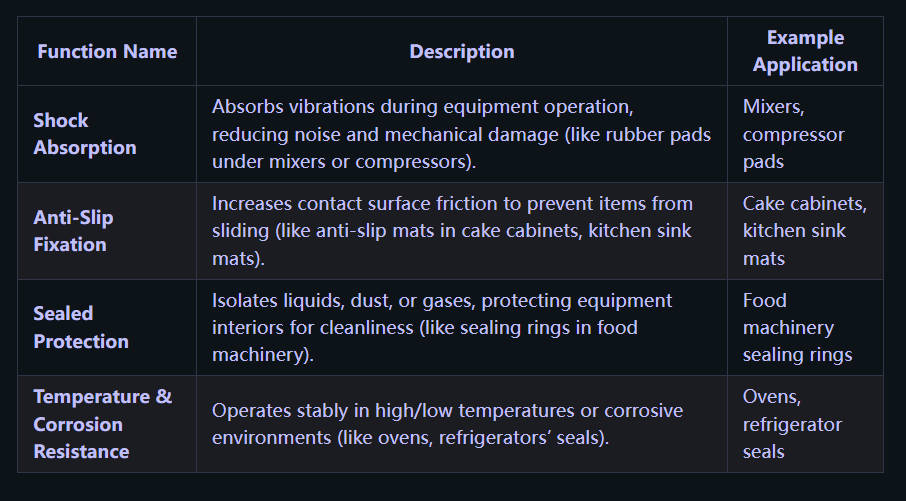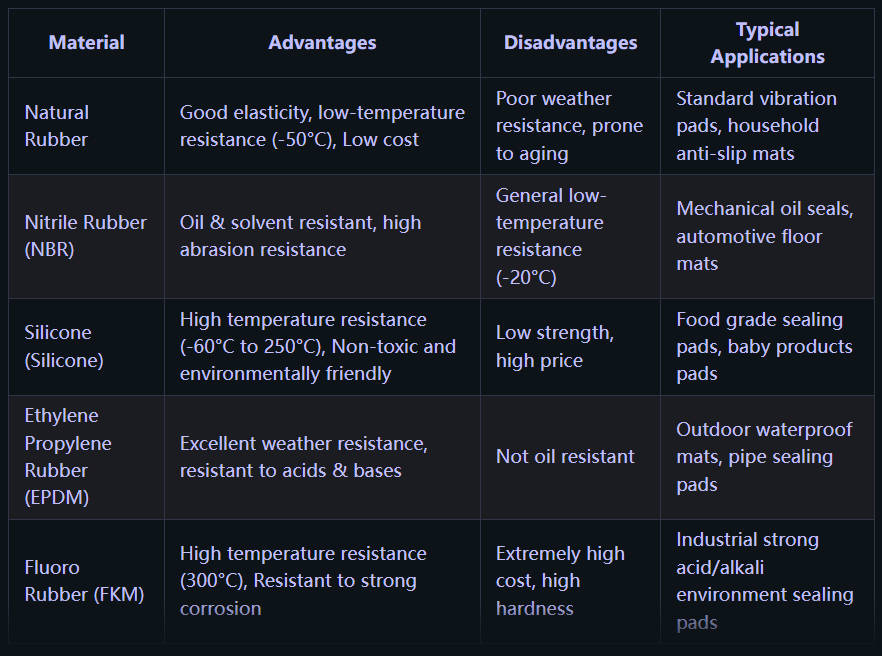What is a rubber pad? How to evaluate the quality?
Mar 31,2025
312
Rubber pad is a sheet-like elastic material made of rubber as the main raw material through vulcanization, molding and other processes. It has the characteristics of wear resistance, anti-skid, shock absorption, high and low temperature resistance, and is widely used in mixers, household, refrigeration equipment, electronics and other fields.

What are the application scenarios of rubber mats?
Kitchen refrigeration equipment includes cake cabinet anti-skid pads, mixer shock pads, oven gaskets, dishwasher waterproof strips, which are all inseparable from rubber pads, which play a role in shock absorption and anti-skid fixation. Nenwell commercial cake cabinets also use this type of rubber pad.

Six core indicators for rubber pad quality evaluation
"Core metrics" usually refer to the most critical and important metrics or data indicators in a field or a specific situation. It reflects the key characteristics and main performance of things, and plays a decisive role in evaluating the status, progress and effectiveness of things.
1. Material safety
For example, formaldehyde, heavy metals (lead, cadmium), and polycyclic aromatic hydrocarbons (PAHs) require third-party testing such as SGS.
Rubber pads that come into direct contact with food must comply with standards such as GB 4806.11 and FDA 21 CFR 177.2600.
Analysis: Inferior rubber pads may use recycled materials, releasing odors or harmful substances, especially for brightly colored and inexpensive products.
2. Physical properties
Hardness (Shore hardness tester test): The higher the value, the greater the hardness. The shock pad is usually 40-70A, and the sealing pad needs to be 80-90A.
Tensile strength (≥ 5MPa) and elongation at break (≥ 200%): the higher the value, the better the tear resistance.
Wear resistance (Akron wear test): wear less than or equal to 0.15cm ³/1.6km, suitable for high friction scenarios.
Analysis: Industrial mats need to focus on tensile strength, while household non-slip mats pay more attention to surface friction coefficient (≥ 0.6).
3. Temperature resistance
High temperature aging: Leave it at a specified temperature (e.g. 150 ° C) for 72 hours to observe whether it is deformed or sticky.
Low temperature brittleness: tested for cracking at -40 ° C, silicone rubber can withstand -60 ° C low temperatures.
Analysis: Choosing the wrong temperature-resistant material may cause the rubber pad to melt at high temperatures (e.g. natural rubber is prone to aging above 80 ° C), or to harden and fail at low temperatures.
4. Chemical resistance
Evaluation method:
Soaking test: immerse the rubber pad in oil and acid/alkali solution to observe the volume change rate (≤ 5% is preferred).
Swelling degree: The lower the swelling rate, the stronger the corrosion resistance (NBR is oil resistant, EPDM is acid and alkali resistant).
Analysis: In industrial environments, it is necessary to choose the corresponding material according to the contact medium, such as fluororubber for contact with gasoline, and EPDM for contact with water.
5. Environmental protection and sustainability
Whether it is recyclable: Silicone rubber and EPDM are easier to recycle, while natural rubber is more difficult to recycle.
Production process: Whether the vulcanization process uses environmentally friendly vulcanizers (e.g. sulfur-free vulcanization process to reduce pollution).
Analysis: European Union REACH regulations, China's "green product certification" can be used as environmental protection reference, long-term use priority to choose low VOC materials.
6. Dimensions and process accuracy
Thickness tolerance: Pads for precision equipment should be controlled within ± 0.05mm, and ordinary pads should be allowed within ± 0.5mm.
Surface flatness: whether there are bubbles, impurities, rough edges, affecting the sealing or anti-skid effect.
Analysis: Customized rubber pads need to provide CAD drawings, and samples should be sampled for dimensional consistency before bulk purchase.

4 Practical Tips for Buying Rubber Pads
Choose silicone rubber or natural rubber for food contact (need to confirm certification), nitrile rubber for mechanical shock absorption, and EPDM for outdoor use.
1. Check the test report:
Require suppliers to provide material composition lists, physical property test reports, and environmental certifications (e.g. ROHS, REACH).
2. Key performance measurements:
Hand tear test: high-quality rubber pads are not easy to tear, inferior products are easy to break; combustion smell: natural rubber smells rubber when burned, and inferior recycled materials have pungent black smoke.
3. Attention to detail design:
The anti-skid pad depends on the surface texture (rhombus, grid pattern is better than smooth surface), and the sealing pad depends on whether the edge is flat without notches.
4. Balancing cost and lifespan:
Short-term use of optional natural rubber (cost-effective), long-term high-load scenarios invest in fluororubber (3-5 times longer life).
Common Quality Problems and Pit Avoidance Guidelines
The new pad has a slight rubber smell. If it is pungent and does not disperse for a long time, it may be that formaldehyde or vulcanizing agent residues exceed the standard. Cracking in a low temperature environment is mostly due to insufficient low temperature resistance of the material, and deformation at high temperature is mostly due to the use of ordinary rubber rather than temperature-resistant materials.
Note: The adhesive model needs to be tested for viscosity (24-hour adhesion ≥ 1kg/25mm), and solvent-based glue (containing benzene substances) should be avoided.
Although rubber pads may seem ordinary, their material, performance and craftsmanship directly affect the life, safety and experience of the equipment. When purchasing, you need to combine specific scenarios, give priority to safety, temperature resistance and suitable materials, and evaluate the quality through test reports and measured data to avoid losing the big because of the small. Whether it is the hygiene and safety of food equipment or the stable operation of industrial machinery, high-quality rubber pads are indispensable "invisible guardians".





